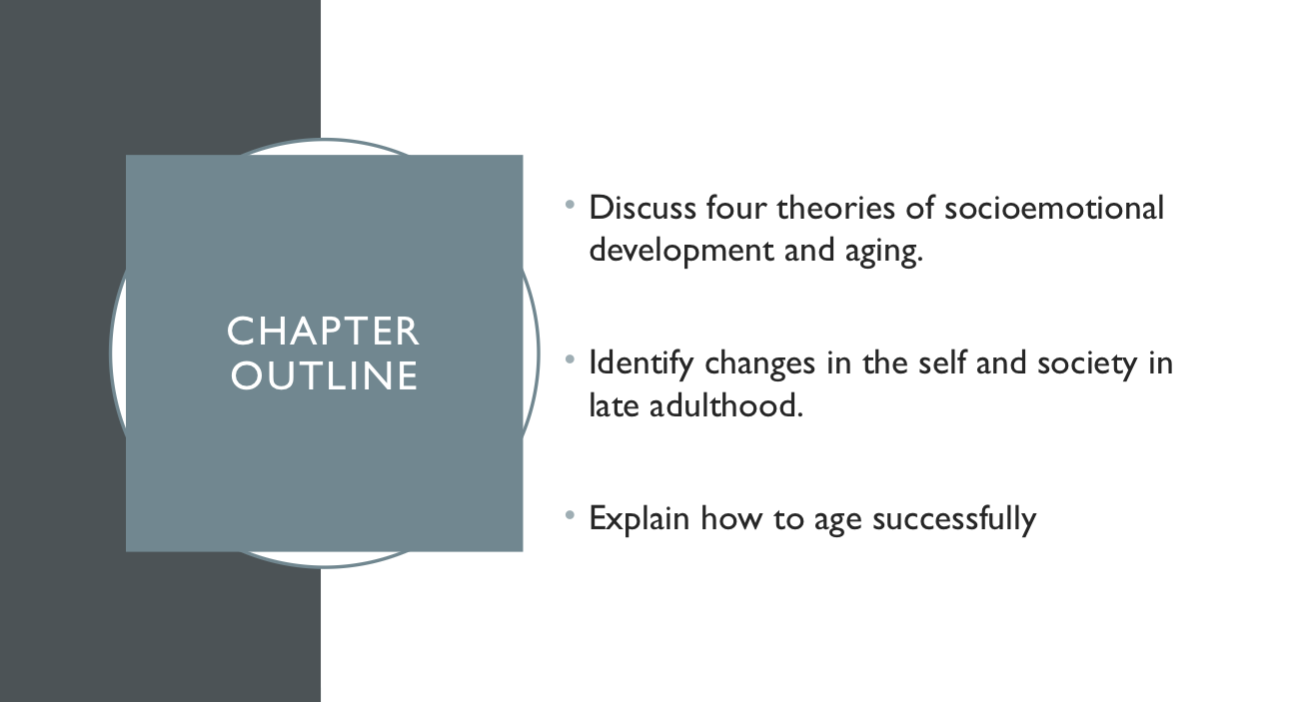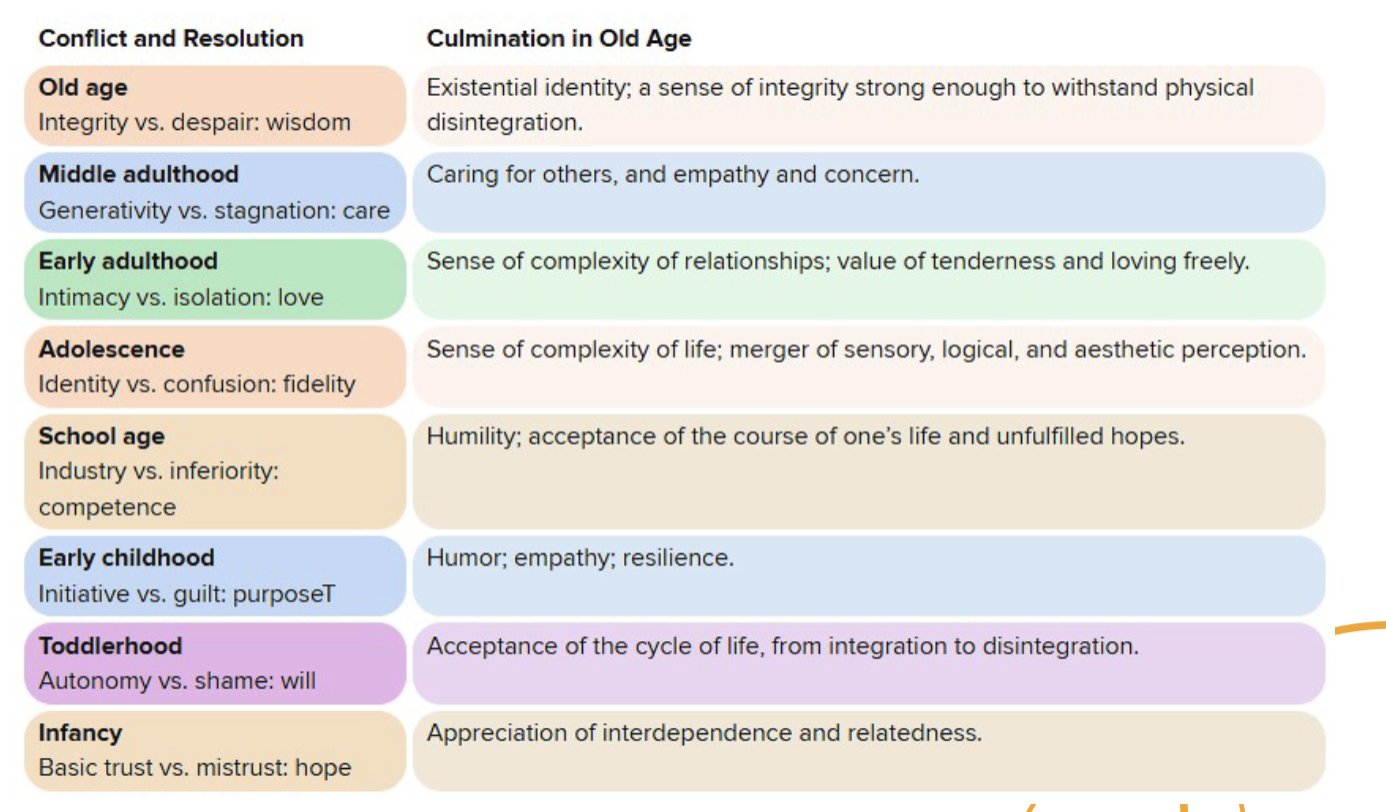Chapter 19

Erikson’s view of the self
Erikson’s 8th psychosocial stage of development is integrity vs despair
Begins in late adulthood (65+)
Individual attempts to find the virtue of wisdom.
As people enter their twilight years, they reflect on their contributions to society
The favorable outcome occurs if the older adult feels a sense of integrity and fulfillment and a willingness to face death.
If the preceding period were developed in a positive way
Those who feel a dissatisfaction with their life experience despair over the prospect of their imminent death
If one or more of the earlier stages were resolved in a negative way

Activity Theory
The activity theory states that the more active and involved older adults are, the more likely they are to be satisfied with their lives.
It suggests that many people achieve greater life satisfaction if they continue their middle-adulthood roles into late adulthood.
If these are lost, it is important to find substitute roles that keep them active and involved.
Retiring from paid employment → do volunteer work
Losing a spouse → join a new social group
Children growing up → help take care of grandchildren
Socioemotional Selectivity Theory (SST)
The SST suggests the decline in social activity in old age is reflective of a life-long selection process where older adults prioritize emotional meaning and satisfaction in ther interactions.
The number of individuals in a person’s social circle tends to fluctuate as we age
Close relationships are maintained while superficial relationships are filtered
This theory challenges the stereotype that the smaller networks of older adults are related to emotional despair.
Instead, it supports that carefully chosen and meaningful social networks lead to rewarding interactions.
Motives for Social Interaction in the SST
There are 2 main goals/motives for social interaction.
Information-seeking: involves reaching out to meet new people
Relatively high in early years, then peaks in adolescence and early adulthood
Interaction with new people can help select a future spouse or life partner, long-term friendships, potential careers, or future interests
Emotional regulation: involves the preference to socialize with familiar partners.
High in infancy and early childhood, declines from middle childhood through early adulthood, and increases again in middle to late adulthood.
Interaction with familiar partners are more intimate and gratifying and tend to yield positive feelings
Selective Optimization with Compensation Theory (SOC)
The SOC states that successful aging depends on 3 factors.
Selection: older adults have reduced capacity and loss of functioning, so they required a reduction in performance in most life domains.
Avoid spreading themselves too thin and improve time management.
Optimization: it is possible to maintain performance in some areas through practice and the use of new technologies.
Get continuous training.
Compensation: is needed when a life task requires a level of capacity beyond the current level of their performance potential.
Try to make weaknesses less visible and accomplishments more visible
Self-Esteem
A cross-sectional study of self-esteem found:
First declines during adolescence
Increases in the 20s
Levels off in the 30s and 40s
Rises considerably in the 50s and 60s
Drops significantly in the 70s and 80s
Explanations for the decline of self-esteem in late adulthood:
Deteriorating physical health
Loss of roles
Loss of loved ones
Negative societal attitudes toward older adults
Stereotyping older adults
Social participation by older adults is often discouraged by ageism - the prejudice against others because of their age.
Especially against older adults
Might not be hired for new jobs or eased out of old ones, might be shunned socially and edged out of family decisions.
Older adults are often perceived as incapable of…
Thinking clearly
Learning new things
Enjoying sex
Contributing to the community
Holding responsible jobs
3 Patterns of Change
Normal aging - psychological functioning peaks in early midlife, plateaus in the late 50s to early 60s, then slightly declines through the early 80s (a marked decline may occur prior to death)
Pathological aging - a greater average decline occurs in late adulthood; may experience mild cognitive impairment in early old age, develop dementia later, or have a chronic disease that impairs daily functioning
Successful aging - physical, cognitive, and socioemotional development is maintained longer than for most and declines later than it does for most people.
Aging Successfully
Many abilities can be maintained and/or improves in older adults with ….
Proper dier
Active lifestyle
Mental stimulation and flexibility
Positive coping skills
Good social relationships and support
Absence of disease